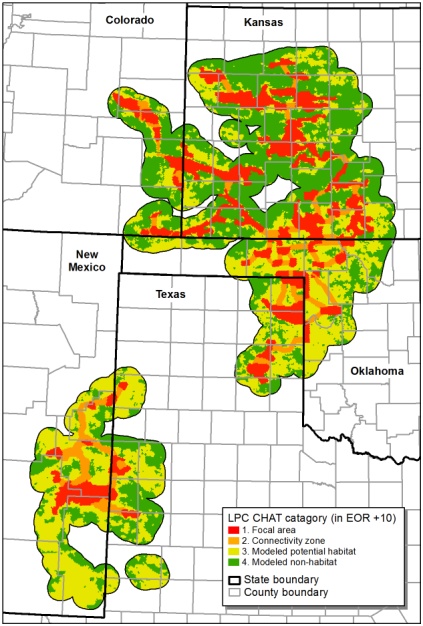Media Contact: Bill Van Pelt, WAFWA Grassland Coordinator, bvanpelt@azgfd.gov, 623-236-7573
New Mexico Landowners Contact: Grant Beauprez, Grant.Beauprez@state.nm.us, (575) 478-2460
February 6, 2014
WAFWA Announces Landowner Sign-Up for Lesser Prairie-Chicken Conservation
The Western Association of Fish & Wildlife Agencies (WAFWA) is now accepting applications through Feb. 28 from agricultural producers in lesser prairie-chicken range willing to implement conservation practices to benefit the species.
Practices include activities such as mechanical brush removal, prescribed grazing, and establishment and management of planted native grass stands. Only producers not currently enrolled in federal farm bill programs will be eligible to apply for five and 10 year contract options. At the end of the sign-up period, WAFWA will score and rank applications based on their value to prairie-chickens and select the highest ranking offers to receive funding. Landowners with accepted offers will receive a sign-up incentive and payments for implementing conservation practices that will maximize the value of their property for prairie-chickens. Payments of up to 125 percent of the estimated cost of implementing the conservation plan will be offered to landowners in high priority locations who are providing optimal habitat to the lesser prairie-chicken.

This map depicts the area of eligibility for the WAFWA lesser prairie chicken conservation program. Offers received from focal areas and connectivity zones will receive higher priority in the application process.
If the species is listed, any take that occurred while implementing prescribed practices would be exempt from the take prohibitions of the Endangered Species Act. Producers who are interested in the program should contact their local state wildlife agency office for more details or to complete an application.
After the sign-up period is complete, WAFWA will develop similar conservation plans for producers who do not desire or do not quality for payments but simply want to be exempted from Endangered Species Act take prohibitions. The prescribed management practices in these plans will be similar to the plans associated with funding; however, livestock stocking rates will not be quite as conservative. However, if the species is listed, any take that occurred while implementing the prescribed practices would be exempt from the take prohibitions of the Endanger Species Act. Producers interested in this type of conservation plan should also contact their local state wildlife agency office to request that one be developed.
WAFWA consists of 23 state and provincial wildlife agencies, including the five state wildlife agencies in Kansas, Oklahoma, Texas, New Mexico, and Colorado. Through WAFWA, those five state wildlife agencies worked cooperatively over the last two years to produce the Lesser Prairie-Chicken Range-wide Conservation Plan as a means to preclude a federal listing of the species. On Oct. 23, the U.S. Fish and Wildlife Service endorsed the range-wide plan as “a comprehensive conservation plan that reflects sound conservation design and strategy that, when implemented, will provide a net conservation benefit to the lesser prairie-chicken.” The amount of voluntary enrollment in the range-wide plan could weigh heavily into the final listing decision which the U.S. Fish and Wildlife Service is expected to announce by March 31.
To see the full the range-wide plan, go to www.wafwa.org. To access an interactive map showing prairie-chicken habitat focal areas, see the Southern Great Plains Crucial Habitat Assessment Tool at http://kars.ku.edu/maps/sgpchat/.

